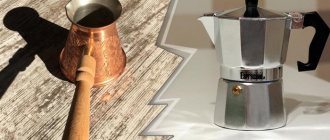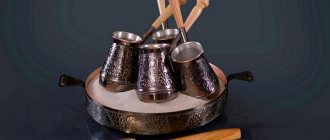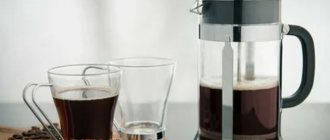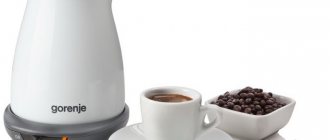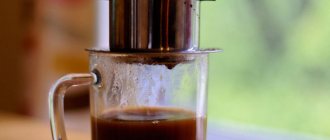Coffee lovers cannot imagine a day without a cup of aromatic espresso flavored with cinnamon, milk, or a delicate cappuccino with lush foam. With this invigorating drink, the day not only begins, but also ends. The modern rhythm of life does not leave time for preparing coffee at home, so they prefer to buy it in cafes and local street shops. But on weekends, you still want to treat yourself to a drink without getting out of bed. What devices to choose in order to brew delicious espresso are discussed later in the article.
General information about the devices used
There is more than one name for cookware for making coffee. In the United States of America alone, about eight hundred patents have been issued for various variations of coffee makers. Essentially, all these devices are divided into two types:
- electrical;
- slab
Slabs require heating. The dishes are placed on the stove. Electric ones simply need to be connected to the mains. There are both simple devices that have been used for centuries, and modern units that perform many functions, including grinding beans and choosing the optimal dosage.
Traditional and tall teapots
Above we talked about how teapots differ in the shape of their spout. There are also different forms of housings. So, they can be tall or traditional. We recommended mainly tall ones: their shape resembles a cylinder. Most electric models have this shape.
Traditional teapots are more flattened and spherical. For example, this type includes Mr. Coffee Flintshire and glass model from Medelco. Typically these devices are used on a stove, but there are also electric models.
Turk
If you answer the question of what coffee is brewed in, the first thing that comes to mind is Turk. Indeed, the oldest and most simple way of preparing a coffee drink, which is still widely used today, is boiling the beans in a Turk (cezve). Already from the name it becomes clear that this dish was invented in eastern countries. They initially used ordinary saucepans to brew the drink, and then for convenience they decided to remove one of the handles. The one that remained was made longer, curved and flattened.
Over time, the Arabs noticed that if the container at the neck was made narrower and the edges widened, the coffee would be much tastier. Thus, dishes with a thick bottom, a narrow neck and a long handle were invented. She quickly gained popularity all over the world.
Nowadays, Turkish coffee is prepared on a stove (gas or electric). The classic recipe involves brewing in hot sand. The following actions are performed:
- The sand is heated for several hours.
- A Turk filled with coffee and water is immersed in it up to the level of the neck.
- When the water approaches the point of boiling, the cezve is quickly removed.
- To fully develop the taste and aroma, such manipulations are repeated 3-4 times.
For those who like to prepare a drink according to the classic recipe, a special electrical appliance has been developed. Visually, it resembles a box filled with sand. When it is turned on, the contents of the container become hot. All that remains is to place the cezve there.
Important! If you have no experience in making coffee, it is recommended to start mastering this process with a copper or ceramic Turk.
Initially, only one type of grain is used. Then you can switch to mixtures and add various spices to the composition.
How to choose?
Ceramics, clay and various metals are used to make Turks. Each of the materials has its pros and cons. Some people prefer practical metal Turks, while others dote on their clay or ceramic “friend.”
A metal Turk is the most durable and unpretentious. After all, the metal will not burst or break, it is easy to wash and clean. Coffee pots are made of copper, silver, aluminum and stainless steel. Copper Turks are the most popular among coffee lovers.
Copper has uniform thermal conductivity, and the Turk itself has the narrowest neck, which is important for making coffee. It is desirable that the copper pot have a special internal coating made of food-grade tin. Turks made from other metals are inferior in quality to their copper counterparts either in heat-conducting properties or in the ductility of the material.
In clay Turks, the taste of coffee is especially unique. Models made from Chinese Yixing clay have high porosity, i.e. are able to absorb the aroma of coffee, making the drink especially tasty. In addition, Yixing clay allows air to pass through well, enriching the coffee drink with oxygen, which allows the aroma to fully develop.
True, the porosity of Yixing clay also has its downside. The fact is that in such a Turk you can prepare only one type of coffee, the one that was brewed in it for the first time. Otherwise, your drink will have a mixed bouquet of aromas of all types of coffee ever brewed in this Turk.
Ceramic Turks are more versatile. You can prepare any type of coffee in them. The quality of the brewed drink in a ceramic pot is very high due to the properties of the material. In addition, the thick walls of the vessel provide a longer boiling process, which continues even after the Turka is removed from the heat.
When choosing a coffee pot, pay attention to the material from which the handle is made. It is desirable that it does not conduct heat, so Turks with a wooden handle are preferable
Little tricks
Coffee was brought from Syria to Istanbul back in 1555, where they began to brew coffee in Turks, which was called in Turkish. To make this coffee, you need to use only finely ground coffee and add spices such as cardamom, anise, cinnamon and cloves.
But how to make Turkish coffee if you have never done it before? To do this, you need to prepare the right Turk, which will correspond to the number of servings being prepared, a stove on which to heat and coffee, ground very finely.
High-quality coffee requires freshly roasted beans. It should be remembered that roasted grains are not stored for a long time, as they lose their extraordinary aroma and taste. It is necessary to grind such beans immediately before preparation, because the best coffee comes from beans that have just been ground. You need to grind very carefully to achieve the finest grind. If the coffee is small, the drink will brew faster and a large foamy cap will form, under which all the beneficial substances, the divine taste and aroma of fresh coffee will be preserved.
To give your coffee a milder taste, you can put a pinch of salt in the coffee pot. It is also important to know that you should not put more ground coffee in a Turkish coffee pot than one or two teaspoons per cup of coffee. This will be unhealthy and excessive bitterness will kill the real aroma and taste of the coffee. Water for coffee should be raw. There is no way to boil coffee, because the foam will collapse and the entire preparation process will go down the drain. When preparing coffee, you must constantly stand near the stove and not be distracted, otherwise you will only ruin the coffee and dirty the stove.
When the coffee is ready, you can add a little cold water to it, then the grounds will settle faster. If you think that the taste of coffee depends on the brand, then you are deeply mistaken. It is important to buy coffee beans and pay attention to the country of cultivation. You should not buy coffee from India or Indonesia. It is best to purchase coffee grown in Central or South America. This coffee is always tasty and aromatic.
If you see that the coffee beans are very dry and have a weak aroma, you do not need to buy such coffee. Most likely he is very old. Also, make sure that there is not the slightest trace of mold on the grains, which happens very often. Good fresh coffee beans should be the same size and color.
Which type of coffee is best for Turkish coffee?
As for the variety, it is best to take Arabica, which is more aromatic, and the grains are quite large and oily. But lovers of strong coffee should choose Robusta, but dilute it with Arabica, it will taste better and there will be a little less caffeine.
To make coffee in a Turk with foam, you first need to heat the Turk a little, and then pour in the coffee and also warm it up a little. Pour in sugar and only then pour in raw cold water in a ratio of 100 ml of water to 2 tsp. coffee. Coffee should be brewed over low heat; as soon as foam rises, the coffee should be turned off. After this, this procedure can be repeated several times. The number of boils depends on the size of the Turk; the smaller the Turk, the less boiling is required. The main thing is that the foam does not burst, otherwise the aroma of the coffee will deteriorate.
In order not to add cold water, you can simply hit the Turk on the table, then the grounds will settle. The color of the coffee will be nut-colored with a light foam. While the coffee is brewing, you need to pour boiling water over the cups to keep them warm, and then pour the finished coffee into them.
In the East, coffee must be brewed with thick foam, because it is believed that if you serve coffee without foam to a guest, you will thereby insult him.
There is one more secret: you need to brew coffee slowly, because if you don’t do this, the coffee will turn out bitter and even sour-bitter. The best crema comes from finely ground coffee. This is precisely why it works.
It takes a long time for the coffee to heat up. Sugar is the best helper for this. In general, sugar slows down the heating process, since it is not the best conductor of heat. Therefore, it is very important in making Turkish coffee. Sugar also helps produce a better crema.
Important! If there are small particles in the finished coffee, this means that the coffee was brewed for less time. So don't speed up the coffee making process.
Types of coffee pots
People have been using coffee pots for more than 6 centuries. For the first time, a coffee jug was introduced in France. It was made of refractory ceramics and heated by an alcohol lamp.
Now such dishes have become an attribute for table setting. It is difficult to confuse a coffee pot with a tea infuser, even in appearance.
Enameled
Enameled coffeeware most often has a strict cone shape. It is made of steel, and the finishing coating is made of food enamel. It is stable and does not oxidize upon contact with liquids.
An enamel teapot is intended for both brewing coffee and infusing it.
These coffee utensils are resistant to high temperatures, so you can brew the drink on the stove. But in this case the portion will be too large. They hold up to two liters of liquid.
Enameled coffee pots have many advantages:
- durability;
- reliability in use. The material does not rust, does not deform or break. Only when the enamel is accidentally chipped does rust appear on the surface;
- cheapness;
- The enamel is resistant to household chemicals, making the coffee pot easy to clean and wash. But when washing, you cannot use metal brushes;
- food enamel does not emit any harmful substances and does not oxidize, so it is absolutely safe for humans.
There are also some disadvantages of such dishes, but they are minor. Among them:
- the appearance of the product is too simple;
- volume only 1000 or 2000 ml;
- The drink cools down quickly.
An enamel teapot will not give any elegance of taste, it does not look very nice. But it is inexpensive and can be used for a long time.
Metal
This category includes utensils made of stainless steel. If necessary, you can heat the coffee on the stove.
A steel coffee pot has its advantages:
- This material does not rust, does not deform and cannot chip. The metal does not oxidize;
- copper products are produced in different volumes - from 250 ml to two liters;
- coffee can be served, infused and even cooked on the stove;
- The dishes have a variety of designs.
But there are also disadvantages:
- metal is expensive;
- heats up quickly, but cools down just as quickly;
- Metal products require special care. They can only be washed with mild detergents that do not contain acids or alkalis;
- sometimes metal absorbs coffee residue
Glass
Glassware for brewing coffee beans is made of special heat-resistant glass. You can not only fill it with a ready-made drink, but also brew coffee directly on the stove. Products made from heat-resistant glass can be either independent or included in coffee sets. This does not affect the quality of the cookware in any way.
The advantages of such products:
- You can cook, infuse and serve any hot drinks in them;
- glassware does not require any special care.
- the volume varies - from 300 ml to one and a half liters;
- have an excellent design;
- Such dishes are inexpensive, so everyone can afford them.
Among the disadvantages:
- high fragility of glass;
- the drink cools quickly;
- Cheap coffee pots may have poorly made handles - they often become deformed and melt.
Coffeeware made from glass is very easy to use and looks great. Therefore, it is suitable for serving any table.
Porcelain
A porcelain coffee pot is the most sophisticated option. Previously, it was considered an attribute of aristocracy. Porcelain tableware is made from a mixture of quartz and spar, which are transformed by firing into a beautiful product of the desired shape. The most reasonable use is to serve a coffee table. But in this case, it is better to immediately pour the finished coffee into cups or other containers.
Advantages of porcelain products:
- pleasant and stylish appearance;
- ease of care and use;
- varied design;
- porcelain exhibits good resistance to temperatures and chemicals;
- the material does not emit harmful substances and does not oxidize;
- coffee does not cool down as quickly as in glass or metal containers.
However, even porcelain products have disadvantages:
- the material is too fragile;
- high price.
Most often, such dishes are used by people who want to emphasize their status in society. But the material requires careful attention and some care.
Ceramic
A ceramic coffee pot is better suited for everyday use than any other. It is made from a ceramic mixture with the addition of inorganic substances and is fired.
Products made from refractory ceramics have the following positive features:
- due to the thickness of the walls, the temperature of the finished drink is maintained for a long time;
- Such dishes are easy to care for;
- ceramics are resistant to temperature changes and safe for humans.
But there are also several disadvantages when choosing ceramic cookware:
- it is much less common than glass and porcelain products;
- high price, sometimes exceeding 3,000 rubles;
- the material does not withstand any impacts.
A ceramic coffee pot is easy to use but expensive. In addition, such dishes require special care to prevent the absorption of odors from drinks.
Coffee pot
The Turkish method of making coffee was widespread until the English physicist Raeford invented the coffee pot at the end of the 18th century. Since then, this simple device has been endlessly improved. Coffee pots, which need to be heated on the stove, are still produced today by manufacturers, including luxury tableware, despite the constant modernization of electrical household appliances.
In general, all coffee makers can be divided into two groups: those that need to be heated on the stove, and electric ones. Moreover, the former can be either ordinary or geyser. Coffee makers of the second type, in turn, are divided into drip-type (filtration) and espresso machines, and recently combined ones have appeared.
Italian coffee pot
In a vessel for preparing Moco Express coffee, called an Italian coffee pot, preparing the drink is quite simple, and the result is excellent even for beginners.
- Pour cold water into the lower compartment.
- Place the required amount of coffee powder into the filter strainer, based on the volume of the device.
- Put on fire.
- Wait until the coffee finishes flowing into the upper tank.
- Remove the finished drink from the heat and pour the coffee into a cup.
Some tips for use
When preparing coffee in a Bialetti geyser coffee maker, the main danger is to burn or overheat the coffee. That's why:
- If you are using an electric stove, on which, unlike a gas stove, it is more difficult to monitor the temperature, then it is advisable to choose the smallest burner and set the medium mode (four out of six is just right). If you want to warm it up faster, you can first set it to six, but then switch to three or four.
- Before the moment when coffee begins to flow into the upper bowl (after a couple of weeks of use, you will accurately learn to predict this moment), you can turn off the burner or even remove the coffee pot from it.
- At the very end of the preparation, there is no need to bring it to the point where the geyser begins to “snort”. At this moment, fiery steam is already flowing, and not hot water, which is harmful for coffee. If snorting does start, you can pour cold tap water over the bottom of the coffee pot, this will immediately stop the process.
- Some water remains in the lower bowl, this is normal.
- Tamping coffee is usually not recommended, but you can actually do it if you want a richer flavor. The main thing is not to compact it too much, you can crush it with a spoon. Well, make sure, of course, that the water is poured below the emergency valve!
- Those who are upset by the too long process of preparing coffee in the morning can be advised to pack the coffee pot in the evening.
There are approximately similar tips in a short video about how to use a geyser coffee maker in general and on different types of stoves (regular electric, gas or induction):
- Geyser coffee maker: How it works and how to use a geyser-type coffee maker
Geyser coffee maker
Geyser coffee makers are very popular, especially in Italy. It is believed that this coffee maker was invented by the Parisian jeweler Jacques Augustin Gandet in 1827, and then improved by the French inventor Durand.
Any geyser coffee maker (designed for making coffee on a stove or an electric coffee maker) consists of three sections. To make coffee, the coffee maker is placed on the stove or an electric heater is turned on. When heated, the water in the lower section forms excess pressure, and steam begins to pass through the coffee in the second section, from where it enters the third section through a special high tube, where it cools and condenses. The coffee grounds remain in the cylinder, and the coffee turns out strong and rich.
Advice! It is better to take coarsely ground coffee; in extreme cases, medium grind.
How much does a geyser coffee maker cost?
First, you should think about finances. Undoubtedly, if you compare the prices of moka coffee makers with the cost of automatic coffee machines, the former will always win. But among the geysers themselves, the price range is quite wide.
For example, some Chinese noname can be bought for mere pennies, but is such a dubious pleasure necessary? If we talk about time-tested brands, then inexpensive geyser coffee makers range from 1000 to 1500 rubles. can be found at GAT The launch model of the famous manufacturer Bialetti – MORENITA also fits into this price range.
The cost of a geyser coffee maker ranges from 1,000 to 10,000 rubles
On average, a classic aluminum coffee maker for 6 cups will cost from 2000 to 3000 rubles. Large-capacity geyser coffee makers (12 or 18 cups) and stainless steel coffee makers will cost more. The most expensive ones will be electric ones with automatic shut-off, temperature maintenance function and other pleasant bonuses. For them you will have to pay from 5,000 to 9,000 rubles.
Which manufacturer should you prefer?
Coffee fans rightly believe that the best models of moka coffee makers are made in their homeland - Italy. The undisputed leader among manufacturers can be called the “progenitor” of all geyser coffee makers – the Bialetti company. The models of this brand include not only classics, but also modern stylish models made of sparkling steel, colored coffee makers, and coffee makers for induction cookers. Bialetti was also able to improve her devices, releasing models with a valve for frothing milk and a valve for frothing cream, like an espresso from a coffee machine.
Italian GAT coffee makers are no less famous in Russia - high-quality, authentic products with an affordable price. Also among the leaders is a large manufacturer of electrical goods, the Italian company De'Longhi, with its electric geyser coffee makers, suitable for both home and office.
You should also pay attention to the stylish coffee makers Ibili (Spain) and BergHOFF (Germany). In terms of workmanship, design and quality of homemade espresso, they are in no way inferior to their Italian colleagues.
Tips on how to choose the right Turk
To order really good cookware online, you should pay attention to the following:
- A standard cezve has a volume of 100 ml. That is, it is designed for 1 person, so for a large family it is better to stop at 350 - 750 ml.
- It is possible to brew truly appetizing coffee while preserving its taste and aroma only in traditional cone-shaped containers.
- For a person who is just acquiring the skills to use a Turk, multifunctional analogues will be optimal: copper, brass, cupronickel options.
- Handle attachment. The service life of the cezve depends on how tightly it is connected to the main part.
- The less decor, the easier it is to care for the product.
- It is good if the walls are not too thin, otherwise the liquid will boil too quickly, reducing the quality of the drink itself.
- When purchasing a container for brewing coffee, you also need to consider the type of gas stove. For example, induction and glass-ceramic models require specialized options.
French press
To understand how a French press works, you need to consider the design of the device. The glass flask contained in it has the same diameter in all French presses. But it varies in volume. The higher the glass vessel, the more capacious it is and the greater the volume of liquid it contains. The flask is made of glass, so we can observe from the side how the drink is being prepared.
The container is inserted into a plastic or metal case. A piston that easily moves up and down is attached to the lid, which rotates in a horizontal plane, and serves as a squeezing press. At the base of the piston (plunger) there is a mesh filter, a steel part and a spring, fastened with a bolt.
Brewing coffee occurs as follows: ground coffee is poured into the body and hot water is poured. After five minutes, using a plunger attached to the lid, the sediment is squeezed out: when pressing on the piston, the latter falls down, and the coffee, in turn, falls to the bottom of the flask and is compacted. A clear drink remains on top of it. Everything is quite simple and effective!
Advantages and disadvantages
Like any kitchen appliance, the French press has its pros and cons. True, the number of advantages significantly exceeds the number of disadvantages.
Advantages:
Electric coffee turk with auto shut-off
- The French press is inexpensive. Such a purchase will be affordable even for a person with very modest financial resources.
- The device is easy to clean. This quality will be especially appreciated by experienced housewives.
- A drip coffee maker usually has a paper filter. The French press has a metal filter that prevents sediment and heavy oils from passing through.
- Compactness of the device.
- The strength of the drink can be adjusted by choosing the brewing time yourself. The main thing is to know how much coffee to put in and how much water to pour.
- Preparing a drink in a French press allows you to fully and accurately reveal the aroma of coffee, and its taste becomes “clean”, devoid of foreign flavors and impurities.
- If you prepare coffee using this device, it turns out less thick, without the bitterness and sourness characteristic of a drink brewed in a Turk.
Weak sides:
- A glass flask is a fragile thing and requires careful handling.
- There is no automation in the French press.
- The device is not safe for children.
- You must have a device for heating water on hand.
Jebena
Jebena is the closest relative of the ibrik. The Ethiopian jebena (Fig. 3) is a squat ceramic jug with convex sides, a narrow neck and a spout slightly shorter than that of the ibrik. A horsehair filter is placed at the base of the spout to retain the grounds.
The Eritrean jebena (Fig. 4) differs from the Ethiopian in the absence of a spout. It is replaced by a groove on the neck. Coffee brewed in a jebene is poured into tiny ceramic cups called finjans.
Rice. 3. Ethiopian jebena
Rice. 4. Eritrean coffee ceremony. Woman pouring coffee from a jebena into a finjan
Local potters sell black and red (or brown) jebens. Black jugs are fired and ready to use. But coffee connoisseurs prefer to buy red, unroasted jabens. Spent coffee is thrown into such a vessel, filled with water and put on fire. After boiling for 1–2 hours, the inside of the jebena becomes saturated with the aroma of coffee and turns black.
Drip coffee maker
Drip coffee makers are produced by many manufacturers, but the key elements are the same for all devices. The following are the basic nodes.
- Cold water reservoir. It is often non-removable and is located at the back.
- A tank or boiler in which heating occurs.
- A heating element.
- Funnel and filter for ground coffee. The funnel in some machines is removable. The filter is self-contained and can be disposable or for regular use.
- Container for ready-made coffee. It can be made in the form of a flask, a coffee pot, and sometimes ordinary cups play this role.
Operating principle of a drip coffee maker
Its operating principle has changed little over the past two centuries, although the device has acquired a modern appearance and some additional functions.
- Water from the reservoir, which is usually located at the back, enters the boiler.
- In the tank, the water heats up and rises up the tube.
- Drop by drop it flows through the thickness of the coffee powder and falls into the lower compartment.
- When all the water is heated and drips through the filter, the coffee is ready.
The coffee grounds remain in the filter and do not stain the cups, and the platform on which the tank with the finished coffee is installed can have a heating function and maintain the temperature of the drink.
Despite the similarity, coffee makers from different manufacturers differ in design, volume, materials, and power. The most differences are observed in additional functions: the presence or absence of auto shut-off, delayed start timer, indication, mechanical or electronic control.
The best teapots
Traditional teapots
Electric kettle Ovente KS88S stainless steel
Ovente KS88S is available in different colors: there is classic stainless steel and a stylish red finish.
This 1100 W device heats water quickly. It is 85% more efficient than traditional stovetop kettles. If you're making multiple batches in the morning, this device keeps the liquid warm for up to two hours. During this time you will have time to prepare coffee. Approximate cost: $19.99
Electric kettle Cuisinart JK-17
The Cuisinart CPK-17 has a modern, sleek design.
Through the illuminated “window” you can always see the water level. The power of the device is 1500 W, so the water boils quickly. You can also choose the heating temperature: there are six settings for this. After heating, the temperature will be maintained for half an hour. This is not much, but during this time you can make more than one cup of coffee. Approximate cost: $42.61
Electric mini kettle Bonavita
Do you travel often but still want to make good coffee?
With Bonavita's electric mini kettle, you won't have to worry about hotel coffee makers anymore. The volume of the device is 0.5 liters, so it will fit in a suitcase. While traveling, you can make a couple of cups of coffee with this device. The power of the heating element is 900 W. There is also a convenient automatic shut-off feature. Approximate cost: $23.70
Electric kettle Oster 5965
If you are afraid of accidentally getting burned in the kitchen, then with Oster 5965 you will no longer encounter this problem.
The heating element of this electrical appliance is hidden, and the handle remains cold, so the likelihood of getting burned is reduced to zero. The stainless steel finish will look good anywhere. The device has an automatic shutdown function. Approximate cost: $59.85
Whistling kettle Mr. Coffee 91407.02 Flinshire
Mr.
Coffee 91407.02 is a classic kettle with a whistle for the stove. Its finish is matte, so it will look great in the kitchen. It cannot be placed in the oven, but it will work on most stovetops. Approximate cost: $10.99
Medelco Glass Kettle with Whistle for Stovetop
Medelco decided to replace the classic glossy or matte stainless steel finish with glass.
This model has a whistle, so you can know when the water reaches boiling point. You can also watch the water heating (if you like) through transparent glass. The appliance is safe to heat on the stove. Approximate cost: $9.88
Ovente KP72W
Ovente KP72W will liven up your kitchen design as this model is available in different colors.
You can buy it in white, purple, brown or other colors. You will be able to find a teapot that will match any kitchen decor. The power of the device from Ovente is 1100 W, so the water will be heated quickly and evenly. For greater safety, the heating element is hidden. This is one of the most affordable electric kettles in this article, so it is suitable for those who are on a budget. Approximate cost: $14.78
Teapots with long spouts
Electric kettle Bonavita with long spout
This Bonavita electric kettle has a stainless steel finish.
It also has a long spout that makes pouring water easier. The water will be quickly heated to the ideal temperature for coffee: the power of the device is 1000 W. Approximate cost: $37.31
Kettle Hario V60 Buono with spout
Hario V60 Buono is a classic stovetop kettle. Its design is both elegant and practical. The device can be placed on any stove. This model is very popular in specialty coffee shops. The disadvantage of this model is that it is somewhat difficult to control the pouring of liquid. If you still prefer to use non-electric kettles to make coffee using the pour-over method, then this option is suitable for you.
Ovalware Slow Dance Kettle with Spout
This newbie brand may appeal to you over established companies.
The Slow Dance model allows you to control the water flow, and the handle is designed with ergonomics in mind. The volume of this device is slightly smaller than that of Buono, but the price is lower. In addition, this device is popular among lovers of both tea and coffee. Approximate cost: $29.99
Espresso machines
According to the degree of automation, espresso machines are divided into:
- Manual (mechanical) espresso machines, in which the required water pressure is achieved through the application of physical force by the operator.
- Semi-automatic espresso machines independently create the required water pressure. Further preparation of the drink is completely controlled by the operator.
- Automatic espresso machines independently create the required water pressure and automatically dose it. At the same time, the operator is still responsible for maintaining the correct proportion and loading of ground coffee.
- Super-automatic espresso machines carry out the entire coffee preparation procedure - from grinding the beans or dispensing already ground beans to pouring the drink into cups.
The most common commercial models of espresso coffee makers fall into the category of semi-automatic, since they combine the relative cheapness and speed of preparing coffee, and also leave ample opportunity to control the taste of the finished drink.
Automatic machines are not widely used in cafes and other establishments because the coffee they prepare does not meet the standards (espresso) developed by the Italian Espresso Standardization Institute. In automatic machines, coffee extraction is much lower due to the inability to achieve the required tamping and pouring time, and the “foam” in automatic machines is obtained by pre-whipping the coffee, and not by extraction as in classic espresso.
Super-automatic machines have become widespread both in everyday life (that’s what they call household machines) and in catering establishments (industrial super-automatic machines), where coffee needs to be prepared in large quantities, there is no specially trained staff (barista) or the ambiance of a classic coffee shop is not required.
Important! Industrial super-automatic coffee machines are much more expensive than regular carob coffee machines, and not all restaurateurs can afford to install such equipment, but in such large chains as McDonalds, Sbarro, Starbucks, etc. they are installed in every restaurant.
Espresso coffee maker
The drink is prepared using steam pressure. This unit can also make cappuccino. To froth milk, you need to place a straw equipped with a nozzle in a container with liquid. Steam will begin to flow through it under pressure. Due to this, foam will appear on the brewed coffee.
The unit works according to this principle:
- the water gradually warms up;
- when the maximum pressure is reached, the valve opens;
- the liquid moves through the tank containing the grains.
Depending on the device model, you can prepare 2-4 cups at a time. Designs that create a pressure of 15 bar are more advanced than those designed for only 3.5-5 bar. In them, the liquid absorbs a maximum of aromatic substances.
For this type of coffee maker, it is recommended to use a special type of product. It's called espresso. These are coarsely crushed grains that have undergone special heat treatment.
Combination coffee maker
Combination coffee makers are actually two models in one. One is a drip coffee maker that can brew a whole liter of coffee, and the other can brew a cup of espresso. Combination coffee makers also have a separate device for frothing milk for cappuccino. Most likely, this coffee maker is suitable for those who cannot decide which coffee they like best: espresso or traditional. Combination coffee makers are very convenient in a small kitchen, as they save a lot of space.
A combination coffee maker is called a coffee machine and can be purchased at any hardware store.
But combination coffee makers have their drawbacks, the main one being that each part of the machine requires specific care and different types of ground coffee. In addition, such devices are not cheap: for the same money you can buy a very decent drip coffee maker and an espresso coffee maker separately.
Conclusion
In conclusion of this review, it can be noted that the most popular, according to buyers, are cezves based on alloys and combinations. Simpler models starting from 200 rubles are perfect for daily use. And an already silver-plated Turk, complete with a set of tray and accessories for it, will be a good gift. Pure steel or copper vessels are slightly inferior to them. Real gourmets are advised to pay attention to glass ceramics. However, if you still can’t determine which company has the best products, you can experiment with them in practice by purchasing a couple at once.
Which is better to choose?
The conclusions are as follows. It’s more convenient to brew in a coffee maker, but it’s faster in a Turkish coffee maker. In the Turk, as in the geyser coffee maker, they add cinnamon, cloves and other spices according to their taste and desire. A large number of processes occur in a coffee maker that change its natural taste.
Making coffee in a Turk requires attention and skill, and the machine will prepare a delicious drink without human supervision. A geyser coffee maker, unlike a Turkish coffee maker, notifies you of the final stage of preparing the drink with a sound signal (hisses).
The coffee in a geyser coffee maker differs in its density and strength from other coffee makers and Turks - the drink is thick and rich. But a Turk is easier and faster to clean than a geyser and other coffee makers. The geyser coffee maker takes a long time to cool down, and you can get burned while preparing the second portion of the drink. Conclusions have been drawn, and the choice is left only to coffee lovers.
Alternative to Turk
If you don't have a Turk on hand, you can brew coffee on the stove in a saucepan or ladle. The rules are the same as for the cezve. To prevent the drink from burning, choose enamel or stainless steel dishes.
Or brew the coffee powder in a thick-walled porcelain or clay cup.
You can also use a coffee pot. This is porcelain or earthenware utensils for the finished drink, which is shaped like a jug or a small teapot with a lid. But you can brew a drink in it just like in a cup.
Modern coffee pots are part of a coffee machine or coffee maker, are made of glass and do not have a lid.

